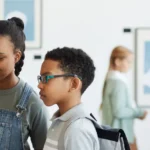At Manthena American School, where we prioritize student success and engagement, firmly believe that interaction is the key to unlocking a world of knowledge and personal growth. In this blog post, we’ll delve into how we, in partnership with our dedicated teachers, have embraced interactive teaching methods to create a dynamic and enriching learning environment for our students.
The Power of Interaction:
Interaction is more than just communication; it’s a dynamic exchange of ideas, experiences, and knowledge. At American School, we recognize that fostering meaningful interactions among our students and teachers is crucial for their holistic development. It’s not enough to simply convey information; it’s about creating an environment where students actively engage with the curriculum, their peers, and the world around them.
Our Commitment to Interactive Teaching:
Interactive teaching is not just a buzzword for us; it’s a core part of our educational philosophy. We understand that every student is unique, and a one-size-fits-all approach to education is no longer effective in today’s rapidly changing world. Hence, we’ve placed a strong emphasis on tailoring our teaching methods to cater to individual learning styles and needs.
Our Teachers: The Driving Force
Our teachers are the heart and soul of American School. Their dedication, passion, and adaptability are the driving forces behind our successful transition to interactive teaching. We’ve provided our educators with the training and resources they need to effectively incorporate interactive methods into their teaching.
Interactive Teaching Techniques in Action:
At Manthena American School, we believe in learning by doing. Our classrooms have transformed into lively hubs of interaction, where students are actively engaged in the learning process.
1. Flipped Classrooms: We’ve flipped the traditional model of teaching. Students access lecture materials online before class, allowing classroom time to be spent on discussions, problem-solving, and practical applications of the concepts they’ve learned.
2. Active Learning Strategies: Our teachers encourage students to participate actively in class through group discussions, debates, role-playing, and hands-on activities. This not only enhances their understanding but also develops critical thinking and communication skills.
3. Real-World Scenarios: We believe in connecting classroom learning to real-life situations. Our teachers incorporate real-world scenarios and projects into the curriculum, giving students a deeper understanding of how their education applies to the world around them.
Measuring the Impact:
The success of our interactive teaching methods is not anecdotal; it’s data-driven. We constantly measure and evaluate the impact of these techniques to ensure they’re enhancing the learning experience.
1. Student Engagement and Participation Rates: We monitor student engagement levels and participation rates in class. Higher engagement indicates a more interactive and vibrant learning environment.
2. Improved Retention and Comprehension: Through assessments and feedback, we assess whether students are retaining information better and comprehending complex concepts more effectively.
3. Success Stories: We celebrate the success stories of our students who have thrived in our interactive learning environment. Their achievements are a testament to the power of interaction in education.
Teacher and Student Perspectives:
To truly understand the impact of interactive teaching, we’ve spoken to both our teachers and students to gather their perspectives.
Our Teachers:
Our journey into interactive teaching has been incredibly rewarding. We’ve seen a noticeable increase in student enthusiasm and a deeper understanding of the subject matter. It’s amazing to witness our students actively participating and taking ownership of their learning.
Our Students:
Learning has become so much more exciting since our teachers started using interactive methods. We feel like we’re part of a community of learners, and our ideas are valued. It’s made a significant difference in how we approach our studies.
Challenges and Solutions:
Transitioning to interactive teaching isn’t without its challenges, but we’ve worked together to find solutions:
1. Resistance to Change: Some students and teachers initially resisted the change. We addressed this by providing workshops and support to help them adapt to the new methods.
2. Technology Integration: Integrating technology effectively was a hurdle. Our IT team worked closely with teachers to ensure seamless technology integration into the curriculum.
3. Assessment and Evaluation: We had to reevaluate our assessment methods to align with interactive teaching. We developed new assessment tools that gauge critical thinking and problem-solving skills.
Interactive Teaching in the Digital Age:
In today’s digital age, technology plays a pivotal role in interactive teaching. We’ve harnessed its power to enhance the learning experience:
1. Utilizing Technology: We use various online platforms and tools to facilitate interaction among students and teachers, whether in the classroom or through virtual learning.
2. Benefits of Online Resources: Online resources, such as multimedia presentations and e-books, provide a wealth of interactive learning materials that cater to different learning styles.
3. Balancing Screen Time: While technology is essential, we’re mindful of balancing screen time with active, offline learning experiences to ensure a holistic education.
Beyond the Classroom:
Interactive teaching extends beyond the classroom walls at ManthenaAmerican School:
1. Holistic Student Development: Our focus on interaction isn’t limited to academic growth. We believe in nurturing well-rounded individuals, and our extracurricular activities and community involvement opportunities reflect this commitment.
2. Preparing for the Future: We’re preparing our students for the workforce by equipping them with skills like critical thinking, problem-solving, and effective communication – skills that are highly valued in today’s job market.
3. Community Involvement: We encourage community involvement as a way for students to apply what they’ve learned in real-world settings. This builds confidence and reinforces their connection to the world around them.
Best Practices for Interactive Teaching:
1. Professional Development: Invest in teacher training and development to ensure they are equipped with the necessary skills and knowledge.
2. Continuous Improvement: Regularly evaluate and fine-tune your interactive teaching methods based on feedback and data.
3. Flexibility: Be flexible and adaptable in your approach, recognizing that different students may require different interactive strategies.
Conclusion:
In the end, at Manthena American School, we’ve witnessed firsthand the transformative power of interaction in education. Our commitment to interactive teaching, supported by our dedicated teachers, has created an environment where students thrive, engage, and excel. We firmly believe that interaction is the bridge to a brighter future for our students and society as a whole.










